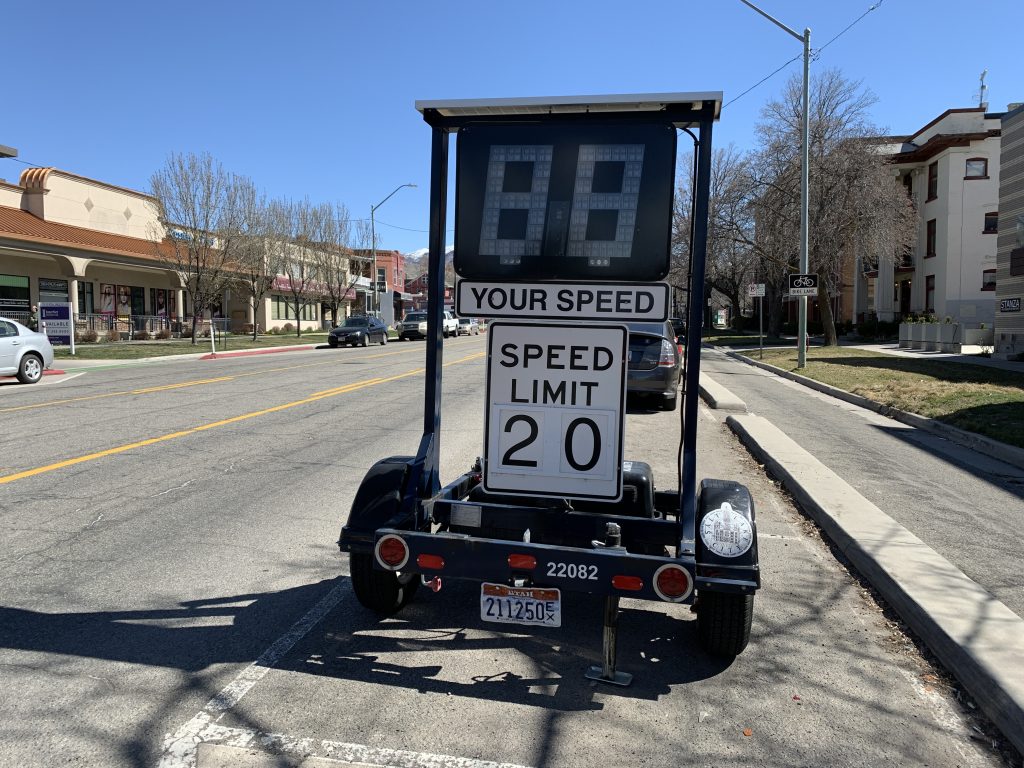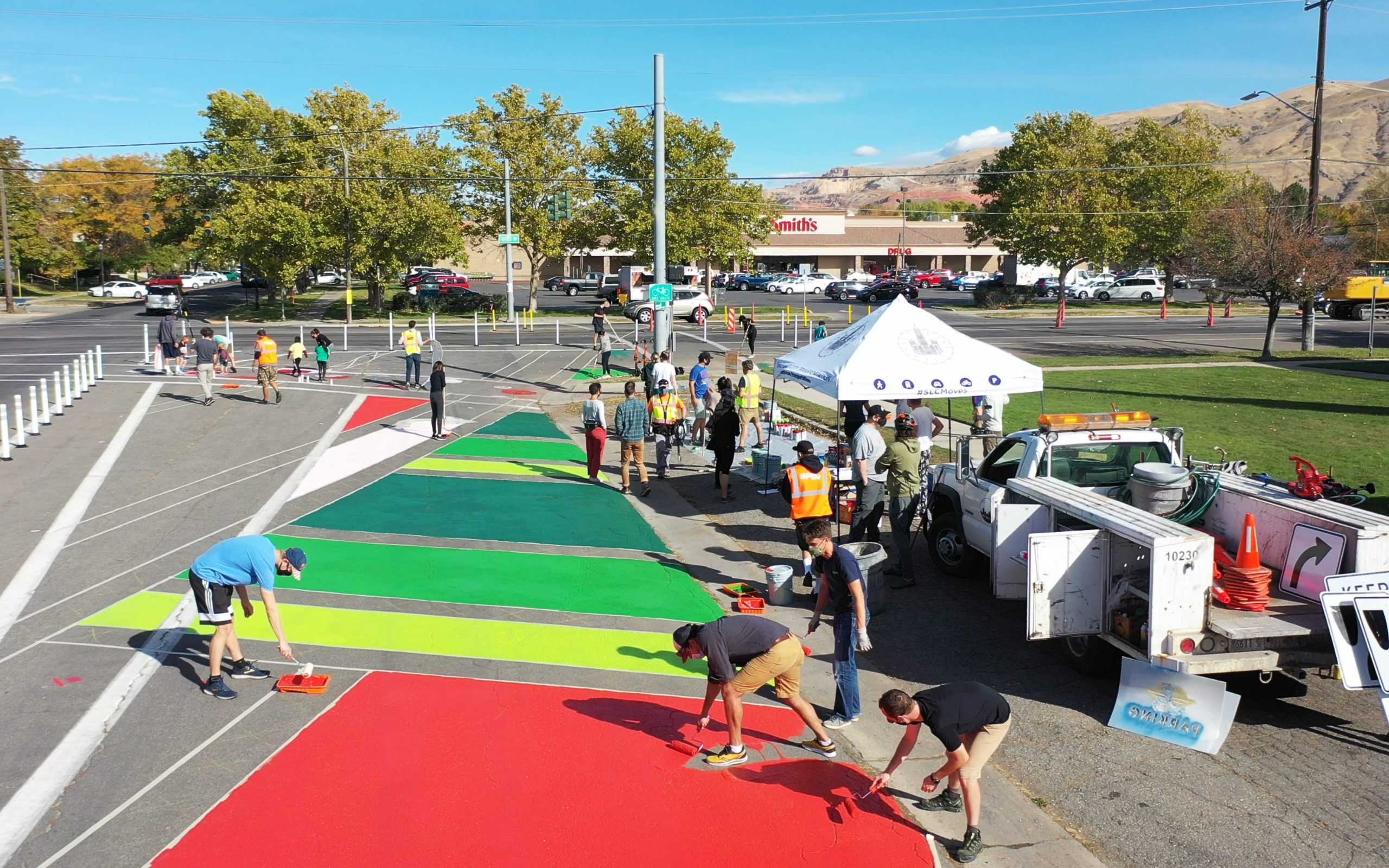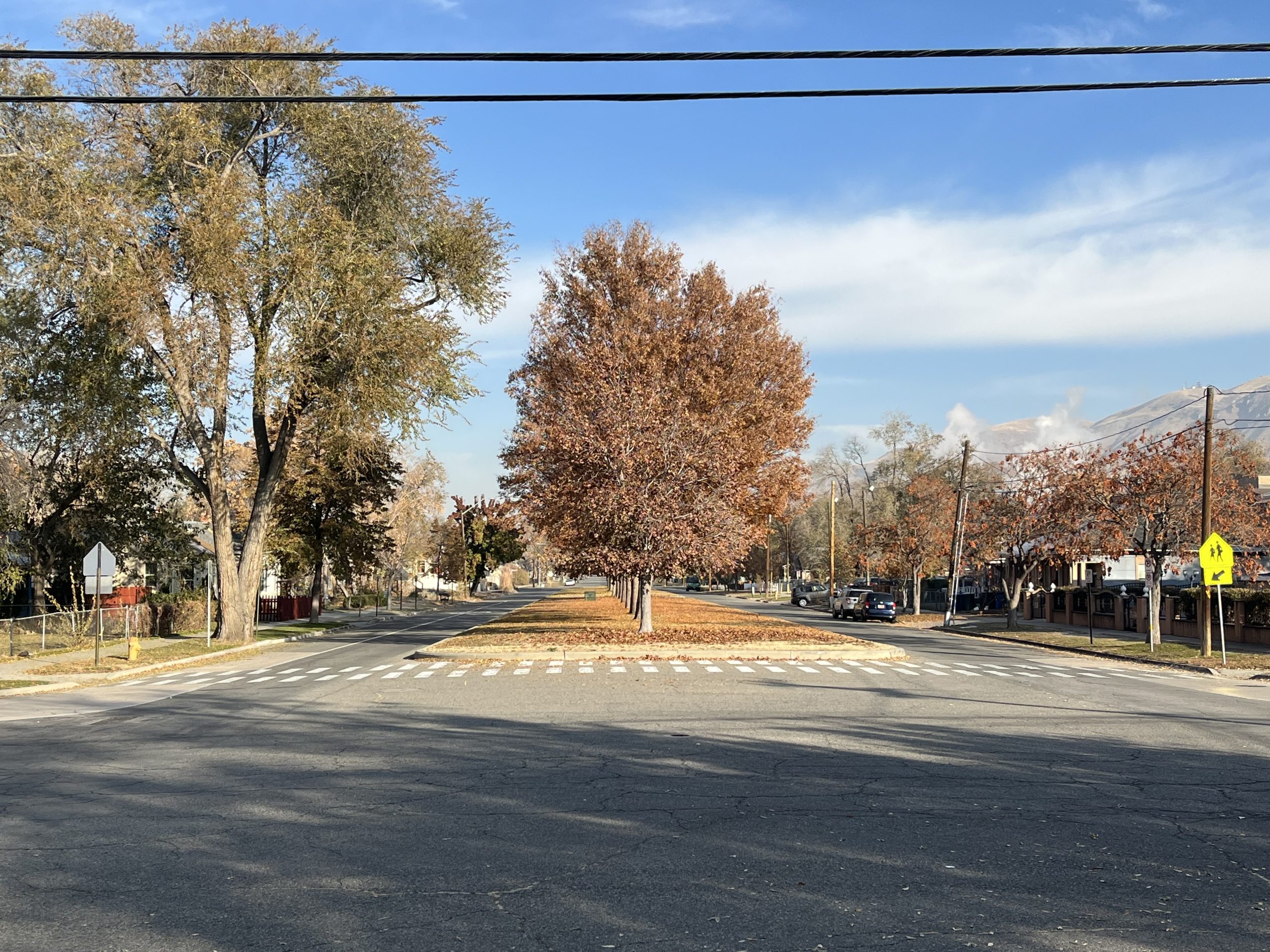Overview
The following treatments are what will be implemented through the Livable Streets program, Neighborhood Byways program, and other traffic calming projects in Salt Lake City. These treatments have been vetted by various departments of the Salt Lake City government, and almost all exist in some form on our streets today.
This toolkit contains 18 different devices that address concerns such as speeding vehicles, high traffic volumes, cut-through traffic, or other safety concerns. The devices vary in their ability to treat various traffic-related concerns.
Explore this page to learn about the different options that may be feasible for traffic calming projects.
Non-Physical Devices
Non-physical devices include any measure that does not require physical changes to the roadway. They are intended to increase drivers’ awareness of surroundings and influence driver behavior without physical devices. Because these devices are not self-enforcing, they have limited effectiveness as standalone devices and should supplement physical devices.
Speed Trailer
More Details
Portable speed trailers visually display drivers’ real-time speeds compared to the speed limit. This device serves as an educational tool, as it allows both the driver and other people using the street to observe the actual speeds at which vehicles are traveling. This encourages the driver to adjust their speed in accordance with the speed limit.
Speed trailers are not a substitute for permanent actions. If the technology allows it, the agency can use innovative strategies that give positive reinforcement for adhering to the speed limit. Scotland’s automated speed signs show drivers who travel the speed limit a smiley face and message such as “thanks for driving safely.”
Advantages:
- Relatively low cost
- Quick implementation/immediate feedback
- Does not require officer to be present
- Can be moved to different locations
- Data can be recorded
Disadvantages:
- Effectiveness may be temporary
Signage
More Details
Signage that can be used as a traffic management measure include truck restriction signs and signs, and general turn restrictions. Turn-movement restrictions involve the use of signs to prevent undesired turning movements without the use of physical devices. The restrictions may generally apply to turning movements in or out of a residential street to a larger street. The turn-movement restrictions may be permanent or only during peak commute hours.
Advantages:
- Truck restrictions can reduce through truck traffic
- Turn restrictions can reduce cut-through traffic at specific times of day
- Does not slow emergency vehicles or buses
- Can increase safety at an intersection by prohibiting certain turning movements
Disadvantages:
- May divert traffic issues to another street
- Turn restriction require enforcement during time of restriction to be effective
Striping
More Details
Lane striping can be used to create formal bicycle lanes, parking lanes, or edge lines. As a traffic management measure, they are used to narrow the travel lanes for vehicles.
Advantages:
- Inexpensive
- Can be used to create bicycles lanes or delineate on-street parking
- Does not slow emergency vehicles or buses
Disadvantages:
- Requires regular maintenance
- Has not been shown to significantly reduce travels speeds
Education
More Details
A variety of education strategies can be used to educate people on the safety risks associated with speeding. Changing driver behavior and attitudes will require increased public safety education. The following strategies can be employed by agencies as funding and Staff resources allow: Brochure – describe the Traffic Calming Program and process. Traffic Safety newsletter (jurisdiction-wide and/or neighborhood specific) – provide information on volumes, speeds, speeding fines (particularly in school zones), and average speeds; describe traffic concerns and recommendations; provide reminders of traffic laws and traffic safety tips for all modes. Website – have a designated page on the agency’s website to provide information on the Traffic Calming Program and the same information recommended for the newsletter. Speed yard signs – implement a public safety education campaign targeting safe speeds. Make yard signs available to the public for free. They should be brightly colored and include phrases like, “Look out for each other,” “Keep kids safe,” and “SLOW DOWN. Drive like you live here.”
Advantages:
- Relatively inexpensive
- Can be implemented incrementally over time
Disadvantages:
- Staff time required to maintain these resources
Speed Feedback Sign
More Details
Speed feedback signs measure each approaching vehicle’s speed. Real-time speeds are relayed to drivers and flash when speeds exceed the limit. Speed feedback signs are typically mounted on or near speed limit signs and are most common in school zones.
Advantages:
- Real-time speed feedback
- Does not physically slow emergency vehicles or buses
- Permanent installation
- Speed and count data can be recorded
- Often solar powered
Disadvantages:
- Effectiveness may be temporary
- May require power source or stop working if solar power is insufficient
- Only effective for one direction of travel
- Subject to vandalism
Speed Control Devices – Vertical
Vertical deflection devices use variations in pavement height and alternative paving materials to physically reduce travel speeds. These devices are designed for travel speeds over the device of approximately 15 to 20 MPH, depending on the device.
Speed Cushion
More Details
Speed lumps are rounded, raised areas placed across the road with two wheel cut-outs designed to allow large vehicles, such as emergency vehicles and buses, to pass with minimal slowing. The design limits passenger cars and mid-size SUVs from fully passing through the cut-outs and requires travel over the lump. They are slightly less than four inches high, typically parabolic in shape, and have a design speed of 15 to 20 MPH. A series of speed lumps are often needed to retain slower speeds over a longer distance.
Advantages:
- Effective in reducing speeds
- Maintains rapid emergency response times
- Relatively easy for bicyclists to cross
Disadvantages:
- Maintenance and snow removal can be challenging
- Vehicles with wide wheel base can pass through the lump using the wheel cut-outs
- Increased noise from vehicles accelerating
Raised Crosswalk
More Details
Raised crosswalks are speed tables striped with crosswalk markings and signage to channelize pedestrian crossings, providing pedestrians with a level street crossing. Also, by raising the level of the crossing, pedestrians are more visible to approaching motorists. Stamped concrete can give the appearance of brick or other textured materials, which would improve the appearance of speed tables, draw attention to them, and may enhance safety and speed reduction.
Advantages:
- Effective in reducing speeds, though not to the extent of speed lumps
- Maintenance easier than speed lumps
- Improve safety for both vehicles and pedestrians
Disadvantages:
- Increased noise
- Impact to drainage needs to be considered
Speed Hump
More Details
Speed humps are rounded raised areas placed across the road, but unlike speed lumps, they do not have cut-outs for large vehicles and bicycles. They are typically 3-3.5 inches high, typically parabolic in shape, and have a design speed of 15 to 20 MPH. A series of speed humps are often needed to retain slower speeds over a longer distance.
Advantages:
- Effective in reducing speeds
Disadvantages:
- Slows down emergency vehicles and buses
- Maintenance and snow removal can be challenging
- Increased noise
- More difficult for bicyclists to cross
Speed Table
More Details
Speed tables are rounded raised areas placed across the road, but unlike speed lumps, they do not have cut-outs for large vehicles and bicycles. They are typically 3-3.5 inches high, typically parabolic in shape, and have a design speed of 15 to 20 MPH. A series of speed humps are often needed to retain slower speeds over a longer distance.
Advantages:
- Effective in reducing speeds
Disadvantages:
- Slows down emergency vehicles and buses
- Maintenance and snow removal can be challenging
- Increased noise
- More difficult for bicyclists to cross
Speed Control Devices – Horizontal
Horizontal deflection devices use raised islands to eliminate straight-line paths along roadways and through intersections.
Traffic Circle
More Details
Traffic circles are raised islands, placed in intersections, around which traffic circulates. Stop signs or yield signs can be used as traffic controls at the approaches of the traffic circle. Circles prevent drivers from speeding through intersections by impeding the straight-through movement and forcing drivers to slow down to yield. Depending upon the size of the intersection and circle, trucks may be permitted to turn left in front of the circle, and the agency can use mountable curbs if turn radii are a concern for emergency vehicles and/or trucks.
Advantages:
- Very effective in moderating speeds and improving safety
- Can have positive aesthetic value
Disadvantages:
- If not designed properly, difficult for emergency vehicles or large trucks to travel around
- Must be designed so that the circulating traffic does not encroach on crosswalks
- Potential loss of on-street parking
Slow Turn Wedge
More Details
Slow turn wedges use markings and flexible plastic posts to buffer pedestrians from traffic and shrink the area where they could get hit by a car.
Advantages:
- Effective in reducing speeds and conflicts with pedestrian/bicyclists
- Discourages drivers from cutting corners and encourage following the proper path when making left turns
- Low cost
Disadvantages:
- Potentially limited to one-way streets
- Less durable than raised concrete islands
Roundabout
More Details
Like traffic circles, roundabouts require traffic to circulate counterclockwise around a center island. But unlike circles, roundabouts are used on higher volume streets to allocate right-of-way among competing movements. They are found primarily on collector streets, often substituting for traffic signals. They are larger than neighborhood traffic circles, have raised splitter islands to channel approaching traffic to the right, and do not have stop signs. Due to large amount of required right-of-way and construction costs, roundabouts may be most appropriate for new developments or redevelopment areas.
Advantages:
- Enhanced safety compared to a traffic signal or stop sign
- Minimizes queuing at approaches to the intersection
- Less expensive to operate than traffic signals
- Can have positive aesthetic value
- Shorter pedestrian crossing distance
Disadvantages:
- May require major reconstruction of an existing intersection
- Loss of on-street parking
- Continuous flow of traffic limits opportunity for pedestrians to cross (compared to signal)
- May present additional obstacles to visually impaired pedestrians
Medians
More Details
Medians are raised islands placed in the middle of the roadway around which traffic circulates. Medians do not always have horizontal deflection. To meet this definition, a median must extend into the travel lane to eliminate the straight-line path and force drivers to slow down to navigate around the measure.
Advantages:
- Effective in moderating speeds and improving safety
- Where pedestrian crossing activity is expected, can provide two-stage crossing opportunities
- Can have positive aesthetic value
Disadvantages:
- Can increase potential for fixed object collisions
- Potential loss of on-street parking
Speed Control Devices – Narrowing
Narrowing devices use raised islands, curb extensions, and other treatments to narrow the travel lane for motorists. They are not as effective as vertical or horizontal devices, but can still provide traffic calming.
Curb Extension/Bulbout
More Details
Bulb-outs and curb extensions extend the sidewalk or pedestrian space to narrow the roadway. Their effectiveness in calming traffic is limited by the absence of vertical or horizontal deflection, but they can still be beneficial. Bulbouts can make intersections more pedestrian friendly by shortening the crossing distance and decreasing the curb radii, thus reducing turning vehicle speeds. Both of these effects increase pedestrian comfort and safety at the intersection.
Advantages:
- Reduces pedestrian crossing distance and exposure to vehicles
- Through and left-turn movements are easily negotiable by large vehicles
- Creates protected on-street parking bays
- Reduces speeds (especially right-turning vehicles)
Disadvantages:
- Effectiveness is limited by the absence of deflection
- May slow right-turning emergency vehicles
- Potential loss of on-street parking
Street Trees
More Details
Trees placed along streets can potentially help reduce motor vehicle speeds and collisions, though studies show mixed results. Streets lined with trees or with landscaped center medians can affect driver perception of lane width, called an “edge effect”. Street trees require irrigation in arid climates
Advantages:
- Low cost
- Positive aesthetic value and placemaking
- Reduces speeds, though studies are limited
- Environmental benefits like reduced flooding and carbon emissions
- Shade enhances pedestrian experience
Disadvantages:
- Requires maintenance
Choker
More Details
Chokers are curb extensions at midblock that narrow a street. Chokers leave the street cross section with two lanes that are narrower than the normal cross section. Their effectiveness in calming traffic is limited by the absence of vertical or horizontal deflection, but they can still be beneficial.
Advantages:
- Easily negotiable by emergency vehicles and buses
- Can have positive aesthetic value
- Reduces speeds
Disadvantages:
- Effect on vehicle speeds is limited by the absence of vertical or horizontal deflection
- May require bicyclists to briefly merge with vehicular traffic
- Loss of on-street parking
- Build-up of debris in gutter
Pedestrian Refuge Islands
More Details
Medians are raised islands placed in the middle of the roadway around which traffic circulates. Medians without horizontal deflection do not extend into the travel lane, maintaining a straight-line path for drivers. While they are not as effective as medians with horizontal deflection, they can still be beneficial. They can act as pedestrian refuges, increasing pedestrian safety, and provide aesthetic benefits.
Advantages:
- Can increase pedestrian safety
- Can have positive aesthetic value
- Reduces speeds
Disadvantages:
- Effect on vehicle speeds is limited by the absence of vertical or horizontal deflection
- Potential loss of on-street parking
Volume Control Devices
Diversion devices use raised islands and curb extensions to preclude particular vehicle movements, such as left turns or through movements, usually at an intersection.
Forced Turn Island (Toucan)
More Details
Forced-turn islands, or toucans, are raised islands that prohibit certain movements on approaches to an intersection.
Advantages:
- Can improve safety at an intersection by prohibiting critical turning movements
- Reduces traffic volumes
Disadvantages:
- If designed improperly, drivers can maneuver around the island to make and illegal movement
- May divert a traffic problem to a different street
Contact Us
Email | livablestreets@slc.gov

















